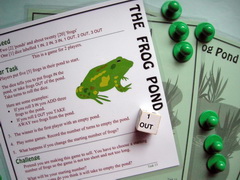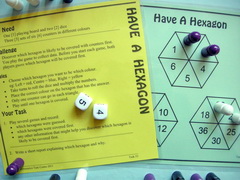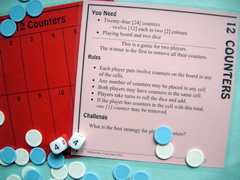|
Poly Plug Puzzles C
 |
These notes begin with support for turning each menu item into a whole class investigation, then link to the companion Task Cameo, which in turn links to Maths300 (where appropriate).
These investigations involve Chance & Data, Computation and are suitable for
Year Levels: 3 - 10
Discover Menu Maths here.
Order Poly Plug here.
|
|

Menu Maths Packs
|

Equipment
- Three plugs per student - one uses yellow, the other uses blue
- One dice per pair
- Three 'cells' labelled A, B & C in which to place the plugs - easily sketched on paper.
Problem
The plugs are placed in the cells in any way, but the objective is for each player to place their three so that they are first to have them all removed under the following rules:
- Roll 1: Remove one of your plugs from Cell A.
- Roll 2 or 3: Remove one of your plugs from Cell B.
- Roll 4, 5 or 6: Remove one of your plugs from Cell C.
|

Visit the Task Cameo for
Task 6, Counter Escape |
Procedure
- Pairs try the problem a few times to get a sense of what happens.
- Class discussion to develop placement strategies.
- Testing of strategies. One way is for each pair to play 25 games.
- How much data is enough? How are the data sets from two strategies to be compared?
- Discussion of the strategies most likely to be best. Do we have enough time to collect sufficient data to compare these likely strategies? How could we organise/arrange to collect the needed data? Following through on these ideas if possible.
- What happens if we change the dice rules?

Equipment
- One Poly Plug set per pair
- One pond each - easily drawn on paper
- One dice per pair marked 1IN, 2IN, 3IN, 1OUT, 2OUT, 3OUT - stickers on wooden cubes can work. An alternative is to use a dice code, ie: 1, 2, 3 mean 1IN, 2IN, 3IN and 4, 5, 6 mean 1OUT, 2OUT, 3OUT
|

Visit the Task Cameo for
Task 13, The Frog Pond |
Problem
This task is a game and the problem is to decide the number of frogs to begin with in the pond to make a 'fun' game. The Frog Pond is similar to Red & Black Card Game, Task 47.
Procedure
- All pairs begin with say 5 plugs in the 'ponds' to represent the frogs.
- Take turns to roll the dice and put frogs in and out accordingly. The winner in each pair is the first to have an empty pond.
- Students need to keep a record of their number of rolls.
- Collect class data on the number of rolls to finish the game.
- Pose the problem: Would the game be more fun if you started with a different number of frogs in the pond?
- Pairs investigate alternatives with a view to preparing a television commercial lauding the advantages of their chosen length of game.

Equipment
- Six plugs and two dice per pair
- A rectangle marked into six sections which are numbered 0 to 5
Problem
To find the best way to place the plugs so that all six are removed in the least number of rolls given that:
- To begin, any number of plugs may be placed in any section.
- A player may remove one plug from a section on each turn, if they have a plug in the section which is the difference of the two dice numbers.
|

Visit the Task Cameo for
Task 34, Dice Differences |
Procedure
- Divide the whiteboard into sections marked 0 to 5. Write these numbers high enough to be seen above the students heads. Make the sections as wide as one child.
- Select six students, explain the rules, and ask them to decide where to place themselves. Record the placement strategy as an ordered sextuplet. For example [1, 2, 1, 2, 0, 0] means:
- 1 student in section 1
- 2 students in section 2
- 1 student in section 3
- 2 students in section 4
- 0 students in section 5
- 0 students in section 6
- Play the game using one larger set of dice that most of the class can see. It will help the students to analyse the probabilities later if the two dice are different colours.
- As you play, call out the two numbers and ask the class to call back the difference. Also choose a student to be the recorder. On an easel (the whiteboard is being used remember) they record both the differences and a tally of the number of rolls.
- Discuss what this experiment tells us about the placement strategy. "Not much." should be the response.
- Ask each pair to play the game with the plugs, their own dice and this first placement strategy. Collect class data about the number of rolls to remove all six.
- Discuss again what this data demonstrates about this placement strategy. Does this information mean that this is the best placement strategy?
- Invite students to choose their own strategies and collect sufficient data to be confident about the average number of rolls for that strategy.
- Over time, collect and display the students' data and keep reconsidering the initial question until the class agrees that the best placement strategy has been found.
- What happens if we change the number of plugs?

Equipment
- Hexagon Board & Blank Board (see Task Cameo)
- Red Poly Plug board per pair
- Two dice per pair (preferably numeral rather than spot dice)
Problem
Roll two dice and multiply the numbers together. Place a red plug beside the product on the appropriate hexagon. Continue until one hexagon has a plug beside each of its sections.
- Which hexagon do you predict will be finished first?
- Which hexagon is actually more likely to be finished first?
- Rearrange the numbers on the hexagons so that they are equally likely (or nearly equally likely) to be finished first.
|

Visit the Task Cameo for
Task 53, Have A Hexagon |
Procedure
- Play the game about 20 times. This should be enough to show that the middle hexagon is more likely to be finished first.
- Investigate the possible ways each product on the hexagons can be made from the dice numbers.
- Make and test a hypothesis about how to rearrange the numbers so that the hexagons have a more equal chance of being finished first.

Equipment
- Twelve plugs per pair
- One board per pair divided into 12 sections numbered 1 to 12 - easily made by folding an A4 paper
- Two dice per pair
Problem
To find the best way to place the plugs so that all twelve are removed in the least number of rolls given that:
- To begin, any number of plugs may be placed in any section.
- A player may remove one plug from a section on each turn, if they have a plug in the section which is the sum of the two dice numbers.
|

Visit the Task Cameo for
Task 117, 12 Counters |
Procedure
- Use a large board (say A3 size) showing 12 sections as two rows of six. Place the board on the floor with the students in a circle, or use a central table.
- Start with the 12 plugs more or less randomly placed, but do include 12 and don't include 1 and another one, say 4. Explain the game (without commenting on your plug placement) by asking a few students to roll two dice and work out the sum. Remove the appropriate plug each time. (Not including 1 is so students don't see too early what happens if one is included and therefore have to discover for themselves that it is impossible.)
- This game is our investigation for today. The challenge is to decide the best way to place the plugs so that they are all removed from the board in the least number of moves. ... Constance, could you suggest a way of placing the plugs to start us off.
- Record the suggestion then, ask each pair to make a board and play the game with the plugs, their own dice and the placement strategy suggested by Constance. Collect class data about the number of rolls to remove all twelve.
- Discuss what this data demonstrates about this placement strategy. Does this information mean that this is the best placement strategy?
- Invite students to choose their own strategies and collect sufficient data to be confident about the average number of rolls for that strategy.
- Over time, collect and display the students' data and keep reconsidering the initial question until the class agrees that the best placement strategy has been found.

Equipment
- One Poly Plug set per pair
- Two cube dice in two colours, eg: yellow and white.
Problem
The captain of a pirate ship is making you walk the plank. But he is a bit of a sportsman and is giving you a chance to be saved. It all depends on the rolls of the dice.
- The plank is 15 units long (15 red plugs).
- You start on the middle unit (the edge of the boat) using a yellow/blue plug.
- One dice tells you which direction to face - right is towards the boat and left is towards the sharks.
- The other dice tells you whether you will walk forwards or backwards and the number of steps to take.
- Yellow Dice: Even roll - face the sharks. Odd roll - face the boat
- White Dice: If you roll 1, 2, 3 walk forward 1 or 2 or 3 steps. If you roll 4, 5, 6 walk backward 1, 2, 3 steps.
Sometimes you reach the safety of the boat. Sometimes you are eaten by the sharks. Either way the game ends. What do you think is the best plank length for a good game?
|

Visit the Task Cameo for
Task 131, Walk The Plank |
Procedure
- Play the game enough times to have a good idea of how many turns it takes to end.
- Choose other plank lengths to explore and repeat the experiment.
- Use the results of at least three different plank lengths to make a case for the best game.
A second reason for using this game is that it models the arithmetic of positive and negative numbers (integers). See the Task Cameo for details.

More Poly Plug & Tasks
|







